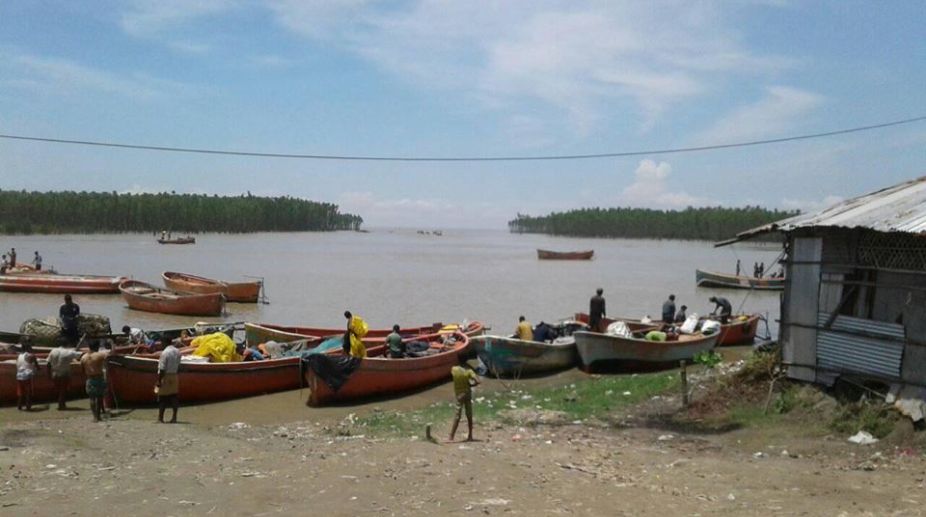Besides Durga Puja and Poila Baishak,’ Ilish season’ in monsoon is one of the three occasions when Bengalis turn spendthrifts. This is mainly due to their inexplicable inborn love for fish, especially the hilsa which forms an integral part of their rituals and traditions. In the past, the groom’s family presented a hilsa wrapped in a red sari adorned with jewellery to the bride’s family. It was marked as an auspicious beginning to the wedding.
Every year, this dedicated love for this particular species of fish begins with dedicating a ‘jodailish’ (pair of hilsa) as a sacred offering to Maa Saraswati, after which the fish is cooked and served to the family that waits in anticipation for this ‘jewel of the sea’. Among all the delicacies that favour Bengalis, hilsa tops the list of their gastronomical delights, particularly during the monsoon season. Bengalis are extremely emotional while dealing with the infuriatingly filled-with-bones but intensely flavoured fish, and it is officially declared ‘King of Fish’ for its taste, texture and look. The ‘King of Fish’ in Bengal is considerably expensive compared tp the pther varieties available in the market. Often the price of hilsa in Kolkata’s markets has crossed Rs 1,500 per kg.
Despite the fact that they are not even as large as buyers would prefer them to be, the biggest is around 850 gms available today and that too only at specific locations. Hilsa is in great trouble currently as the modern demands for eating the fish throughout the year has led to a catastrophic depletion of the species. To cater to the high demand, fishermen are indulging in overfishing of the juvenile hilsa which is affecting the population at large.
The sharp deterioration in both the quality and quantity of the river water has been one of the factors behind the decline of the hilsa population. However, a ban on the fishing of hilsa during the breeding season of April, May and June can usher in a good catch later. Imposing strict fines on anyone buying and selling fish that weighs less than 300 gm can hopefully save the population. West Bengal State Government has passed a law empowering the Fisheries Department to arrest and fine anyone caught fishing the smaller species of hilsa. But it is of no use, as nobody has stopped illegal fishing and the average size of hilsa continues to shrink every season.
Padma ilish is the only variety available today and Ganga ilish is only becoming scarcer because of the polluted river water. A recent overturning of a loaded fishing vessel caused a loss of tonnes of hilsa in Namkhana, a fishing harbour on the Hatania-Doania river, 103 kms from Kolkata. The harbour is famous for exporting Hilsa, Loita (Bombay Duck), Pomfret, and Parshe. Namkhana situated near Diamond Harbour, though called a harbour is actually a fish loading site as it does not possess any facilities of a proper harbour. The area is in a dilapidated condition and prone to casualties for fishermen working at the loading and unloading site.
“We had built this harbour 12 years ago and it is still being used in the same condition without any kind of renovation in the recent past. It had cost us Rs 25,00,000 to build it at that time,” said Atal Maity, spokesperson of the Fisherman Union. Because of the poor condition of the fish loading site, the fishermen have to anchor the trawlers at a considerable distance while speed boats carry the fish back to shore.
The flimsy brick embankment can collapse any day resulting in casualties to both the fishermen and those working on the shore. When asked about the fishing of ‘khokailish’ (baby ilish, less than 300 gms), Atal Maity explained how it gets stuck in the fishing nets making it impossible to separate from the catch of the day. The one kg hilsa is not available these days due to this unfortunate situation. Fishing in Namkhana is prohibited in the months of April and May as it is breeding season for the species. Maity has 250 trawlers under his union with 5,000 trawlers belonging to Namkhana and 10,887 trawlers to Kakdwip-Namkhana-Frazergung union.
During hilsa season which begins from 15 June, the harbour makes a business of Rs one crore each day. The fish caught are then taken to the wholesale markets of Diamond Harbour, Sealdah and Patipukur. The fishery union of Namkhana has sent a petition to Chandrakanta Sinha, Minister of Fisheries requesting a renovation of the harbour and improvements of the boats. “We have left it all to Allah now, as we are tired of requesting the administration to help us in upgrading fishing technology and aid to rebuild the harbour,” lamented Sheikh Abdul, Labour Union Secretary of Namkhana.
The fishermen have life insurance and their boats are equipped with GPS and registered under the union which maintains a logbook containing details of every fisherman that goes out to sea. However, they often face threats from Bangladeshi sea pirates who kidnap them and hold them for ransom to the Indian government. Kakdwip Harbour, about 15 kms from Namkhana is in a much better condition than Namkhana.
“We go fishing eight to ten times in a month and get Rs 1,000 to Rs 1,500 per trip. Each trawler contains about 2000 kg to 2400 kg of fish. This year we have had a good hilsa season,” said Dipankar Das a fisherman who was unloading the vessel Subhadra Narayan in Kakdwip. He however alleged that the owners are the only ones benefiting from the business while labourers like him are living in poverty. Kakdwip, unlike Namkhana, has an ice plant facility and cold storage. There are also many women daily wage labourers who sew fishing nets for their livelihood.
“We stitch nets and get paid Rs 300 to Rs 500 per day. If they increase our pay by Rs 200, it would benefit us as it is difficult to bear household expenses on our current salary”, said Purnima Das who supports her family by mending the giant nets used for fishing. People here are desperate for a stable source of income as demonstrated by Nila Das who is one such individual that has to bear all of her household expenses while worrying about the fate of her four daughters as she is the sole provider of her family.
Overfishing of the hilsa is a serious cause of concern and steps need to be taken to ensure that the species, which is a favourite delicacy for Bengalis, does not turn extinct. The writers are students, Statesman Print Journalism School










